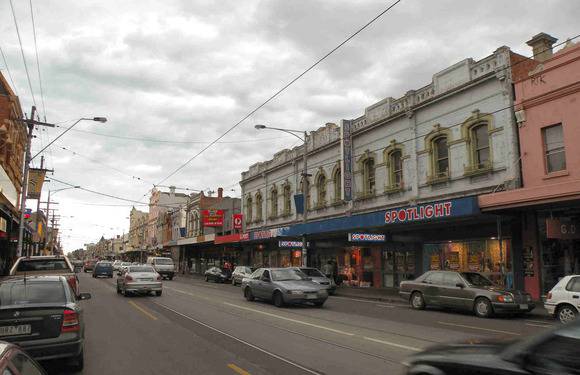| Back to search results » | Back to search page » |
|
Sydney Road (Brunswick)
LocationSydney Road,Brunswick, Moreland City
File Number3535LevelIncluded in Heritage Overlay |
|
Statement of Significance
What is significant?
The Sydney Road Brunswick Precinct, comprising buildings at 272-288 and 251-281 Albert Street, 194-194A Albion Street, 1-7 Ballarat Street, 276-276A & 293-295 Barkly Street, 16-22 Black Street, 1-5 Curtis Place, 1-67 David Street, 1-3 & 10-16 Dawson Street, 1-11B & 4-10 Edward Street, 1, 3-5, 15-17, 23-27 & 29 Frith Street, 2-6 & 8-10 Glenlyon Road, 1-4/16 Gullidge Lane, 1-2 Hope Street, 1-4/1A Little Gold Street, 7 McDougall Street, 1A-17 & 2-4 Merri Street, 1A-1D & 2A Michael Street, 2, 4, 1-2/8, 1-12/22 & 70 Saxon Street, 1-7, 2-8 & 1/10 Sparta Place, 2A-2E Staley Street, 1-1A Stewart Street, 1-697 & 2-702A Sydney Road, 1-2 & 22-24 Tripovich Street, 1 Union Street, 292-334 & 275-291 Victoria Street, 2A Weston Street, 1 & 2-12 Wilkinson Street and 1 William Street, is significant. Buildings and features that contribute to the significance of the precinct include:
- the late 19th and early 20th century retail and commercial strip with largely intact upper floor facades
- the institutional buildings in the late 19th and early 20th century, including the Town Hall and Municipal Offices, the Brunswick Baths and numerous churches of the major 19th century denominations along both sides of the road
- concentration of religious and community focused places in the area, established during the late 19th century
- the diversity of new restaurants and food outlets which developed along Sydney Road serving the southern European and Middle Eastern migrant communities who settled in Melbourne's northern suburbs following the Second World War
- historical public realm elements including bluestone kerbs and gutters, bluestone-pitched crossings, crossovers and central drains, as well as street furniture retained including an early lamp standard, early signs, monuments and drinking fountains.
Significant properties include:
- Brunswick Baths at 16 Dawson Street (HO61)
- Former Lyric Theatre at 199-201 Sydney Road (HO151)
- Mechanics’ Institute at 270 Sydney Road (HO154)
- St Ambrose’s School & Hall at 1-3 Dawson Street (HO155)
- Cumberland Arms Hotel at 337-341 Sydney Road (HO156)
- Former Union Bank of Australia at 387-389 Sydney Road (HO158)
- Duke of Edinburgh Hotel at 430 Sydney Road (HO160)
- Baptist Church at 491 Sydney Road (HO162)
- Former Dental Surgery and Residence at 503 Sydney Road (HO163)
- Independent Church at 523-527 Sydney Road (HO167)
- St Ambrose’s Church at 289 Sydney Road (HO248) & House at 33 Saxon Street (HO142)
- Telephone Exchange at 3-5 Frith Street (HO299)
Non-contributory properties include:
- Albert Street: 272-276 and 278-282.
- Albion Street: 194 – 194A
- Barkly Street: 267-276A
- Black Street: 6 & 22
- Breese Street: 20
- Curtis Place: 1 & 5
- David Street: 1, 17-21, 23, 51, 53, 55, 57, 59 and 61-67.
- Edward Street: 4, 4A, 6, 6A, 8, 8A and 10.
- Frith Street: 1, 15-17, 23-27 and 29-31.
- Gullidge: 16
- Hope Street: 1 – 1C
- Little Gold Street: 1-4/1A
- Merri Street: 3-17.
- Michael Street: 1A-1C
- Saxon Street: 6, 8 & 22
- Sparta Place: 1-7
- Staley Street: 2A, 2B and 2C
- Sydney Road (west): 17, 47 (rear section), 49-53, 65-79, 81-83, 87, 101-101B, 105 -113, 107, 109, 163, 169, 171, 175, 177-179, 209-209A, 259-259A, 329-331, 343-345, 356-360, 369A-371, 409-411, 413-419, 429-433, 435, 435A, 451-457, 485, 487,489, 529-531, 574, 597-605, 633, 635-639, 643, 655-661, 663, 671-673 and 675.
- Sydney Road (east) 2, 4, 6, 20, 30-32, 56, 74-78, 112-118, 120-124, 156-160, 194-198, 200-204, 242-242A, 260, 286-298, 300-304A, 306, 308-310, 320-338, 356-360, 362-366, 392-396, 416-418, 520-522, 536-542, 568-572, 574, 584, 586-588, 590, 602-604, 606, 614-624, 630, 640-642A, 648-658, 672-676, 682-688 and 690.
- Victoria Street: 275, 283, 287-291, 292-302, 316-316A, 320-322, 326-326A and 334.
- Wilkinson Street: 1 and 2-12.
- William Street: 1
How is it significant?
The Sydney Road Brunswick Precinct is of local historical, representative and social significance to the City of Merri-bek.
Why is it significant?
The Sydney Road Precinct is of local historical significance as a predominantly intact late 19th and early 20th century retail and commercial strip, which includes a large number of the important institutional buildings added during this period, including the Town Hall and Municipal Offices, the Brunswick Baths and numerous churches of the major 19th century denominations along both sides of the road. The precinct, which encompasses nearly half the length of Sydney Road, Brunswick reflects the considerable expansion and growth of the street, and the suburb as a whole, during the 19th century Boom period. (Criterion A)
The Sydney Road Precinct is of local architectural significance as a predominantly intact example of a late 19th and early 20th century retail strip that contains some of the key institutional buildings of the period. The capacity of the precinct to represent this period of development is enhanced by the largely intact upper floor facades of the shops. (Criterion D)
The Sydney Road Precinct is of local social significance as an important retail, commercial, religious and community focused area during the late 19th century and for the southern European and Middle Eastern migrant communities who settled in Melbourne's northern suburbs following the Second World War. These latter communities created new eating habits and styles through the diversity of new restaurants and food outlets which developed along Sydney Road to serve them. (Criterion G)
Group
Retail and Wholesale
Category
Retail or Wholesale Precinct




